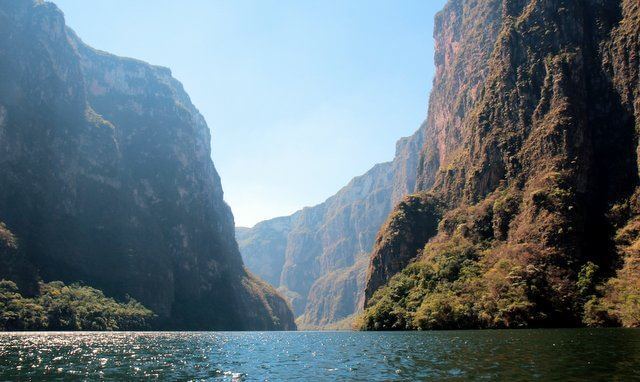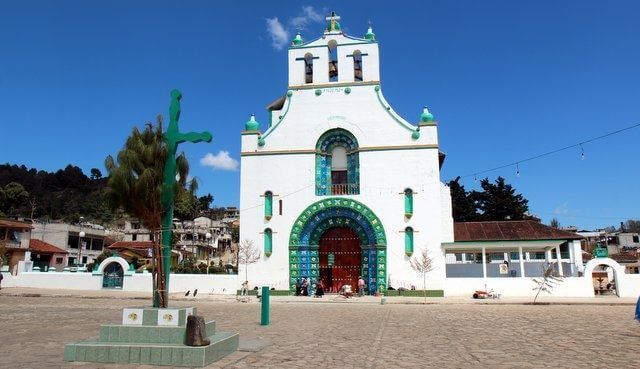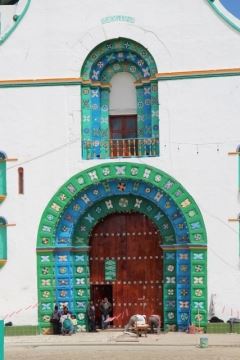
The high walls of Sumidero Canyon
As we rattled along the Sumidero Canyon in a motorboat I was distracted. Something that’s been bothering me for a while now, after travelling for so long, is that certain beautiful aspects of travel can become mundane. The captain was doing his best, but after watching thousands of ibis take flight in the Venezuelan Pantanal seeing a pair of pelicans isn’t mind-blowing. Memories of tip-toeing barefooted through a Gambian crocodile farm at midnight makes the sight of a lone basking alligator merit a brief – “Oh, okay”.

Birds in Sumidero Canyon
Sumidero Canyon is reasonably pretty, but I couldn’t get as enthused as some of the other passengers, as was a bit jealous. The same goes for crossing rope bridges, doing bungee jumps and sitting on the beach.
The worst victim of this is churches.
Everywhere in the world there are churches, temples and shrines and an endless stream of visiting tourists. The two worst places for this were Egypt and South East Asia.
On a group tour of Egypt we averaged 2-3 temples a day. Somewhere between starting in Cairo and finishing three weeks later in Karnak I became completely “templed out”. A year later I went on a Thailand, Laos, Vietnam, Cambodia circuit. Wherever we stopped, there was always a nearby “unique” temple that I felt like I ought to see or I might be missing out. By the mid-point of the 6-week trip I was skipping the temples, and finding cooking classes or bike rides to get away from it all.
So when we arrived in San Cristobal the evening after Sumidero Canyon and I asked what was interesting nearby, I was a bit depressed that the overwhelming response was that I just had to see San Juan Chamula – a church. “Oh, okay”.

The main square of San Juan Chamula
San Juan Chamula
A short collectivo ride got us to the village of San Juan Chamula. The surprisingly large town square was dominated by a tall white church. Our driver stipulated we could go in but must not take any photos. Previous tourists had disregarded this warning and had their camera forcibly removed and destroyed. There’s no police or military allowed here to keep order – the Chamulas have their own enforcers.
Packing the cameras away, we went inside.
The first thing that struck me was the lack of furniture. The central area of the church is bare, with just green pine boughs scattered across the floor. The walls are lined with wooden statues of local saints – some wear mirrors to deflect evil, others are stored upside down as punishment for letting the previous church burn down.

San Juan Chamula Church – this is as far as the camera goes
The church of San Juan is considered a hospital. People come from the surrounding countryside to pray and heal the sick. Despite the number of worshippers, there hasn’t been a congregation for years. Instead the individual devotions here draw on pre-Mayan influences, some Catholicism and one or two unexpected new ideas.
The church has 5 types of lloles, or shaman: bone, plant, animal, mountain (for general prayers), and blood. Depending on whether the illness is physical, psychological or spiritual, these lloles will prescribe different forms of prayer.
The Chamulas kneel on the floor, set up their candles and sacrifices, and then chant in an arcane form of the Tzotzil language. These prayers release the sickness from the diseased souls.
The more severe the illness the more candles and more colours of candles are required. Also eggs, flowers and petals can be waved over the patient to draw out the sick spirits. In severe cases a chicken may be killed to remove curses. Eating the meat would pass on the curse so is avoided, although the sullied meat can be intentionally fed to enemies.
The sickness released into the air must then be breathed in by the praying people. To avoid becoming ill themselves they then burp to force out the disease. In the past people drank chicha or Pox (pronounced Posh, a 38% proof cane alcohol) to induce burping.
At some point, representatives of Coca-Cola came to the town and sponsored huge advertising signs, a local football field (and some say the local mayor). Once everyone was drinking Coke they planted the idea that their drinks were specially designed to produce spiritual burps. The subsidised drinks are much cheaper than the local Pox, which may have swung the townspeople more than tradition.
Now the worshippers can be seen sipping from bottles of Coke and Fanta to produce their burps. There’s no-one drinking the unholy flavour of Pepsi.
The roof of San Juan Chamula has banners arcing upwards to symbolise the original mountain setting, and the floor is strewn with pine needles. The church is cleaned out and the pine branches replaced every three days. We were there early on the third day, and the heady smell of pine, hazy smoke and burning copan resin leant an otherworldly feel to the whole proceedings.
I didn’t take any photos of the inside, but did find one on the web, here. I’m torn about linking, but it seems too high quality to have been taken surreptitiously.
There are also a couple of videos on YouTube from less scrupulous travellers, but I’m definitely not going to link those. If you do seek them out, take note of the outrage in the comments section from both Chamulas and more respectful visitors.
Despite it being understandably forbidden to interact with any of the worshippers inside San Juan Chamula church, it was incredibly interesting, and definitely one of those utterly unique, possibly once-in-a-lifetime experiences that I relish, and worthy of a whole lot more than an “Oh, okay”.
I appreciate that having too much choice, time and freedom to travel is not something to take for granted, but are there any once places that you see on route and where you once marvelled, you now just think “Oh, okay”?






Living in China, the temples do become old news. Though, I think the biggest thing for Zach and I are animals. We detest going to zoos/random Chinese forest parks. After seeing monkeys in the wild, seeing them in a concrete cage is just blah and a tad upsetting.
I wrote about Beijing Zoo a while back – it’s an utterly depressing place
Steve, I understand! See my most recent post about the Milan Duomo, and I do love churches!
More importantly, GREAT post and love your humor. I’ll be sure to keep a Pepsi on hand.
Just read it – looks like we were having the same thoughts (Link: http://adventuresofacarryon.com/2013/06/30/postcard-duomo-di-milano/)
Pingback: Penny Sadler (@PennySadler)
Pingback: @fieldinghannah
Pingback: @jamesbryronlove
Totally human that you can become satiated by anything and everything. I’m glad you got to visit San Juan. Are you continuing south? The mix of Mayan and Catholic religion keeps getting more interesting. I saw a chicken sacrificed in Guatemala…
Ah, yes, I can relate to your temple fatigue. We spent a good chunk of this winter in Spain, and I have to admit to getting a little blase about the churches and castles.
I love that you respected the wishes of the Chamulas and didn’t take any photos.
I feel like this place was at the beginning of a film…? Or perhaps some special I watched on TV? I love anything creepy, haunted or way out there, so I’d love to go!
Spiritual burps — who knew? I’ll never think of Coca Cola — or its inevitable effects — the same way again.
i’m laughing at the spiritual burps, too. fascinating!
Pingback: Sandra Foyt (@SandraFoyt)
How frustrating to not be able to photograph such an interesting place, but kudos to you for doing the right thing.
i love it how coke is controlling this too. god. you’ve done great. thanks for sharing also the frustrating bits of travel politics. gabi
Pingback: @chaseTHEdonkey
I’m glad that in the end you chose to be respectful. I always feel torn when I see signs indicating no photos are allowed because I know the place will draw more visitors if people can see photos. However, we always follow the local customs because respect is more important than more tourists.